| |
|
|
| |
Acapella Audio Arts
|
SPHÄRON Excalibur |
$325,000.00 |
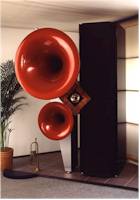 |
Frequency response (Hz) |
N/A - 50K Hz |
| Sensitivity (dB/1W/1m) |
100 |
| Impedance |
N/A |
| Maximum power handling |
100 W continuous 1000 W
peak/10ms |
| Recommended power |
15 watts/4 ohms or greater |
| Phase correct |
Yes |
| Time correct |
Yes |
| Weight (lbs. per speaker) |
1360 lbs. |
| Overall measurements (HxWxD) |
8' 2.4" x 4' 11" x 4' 3.2"
(includes horns) |
| Recommended room size |
40 square yards or greater |
| Speaker type (Traditional
cone, planer, electrostatic, horn) |
Mixed (horn, plasma, cone) |
| Other |
|
|
Campanile |
$75,000.00 |
 |
Frequency response (Hz) |
N/A - 50K Hz |
| Sensitivity (dB/1W/1m) |
92 |
| Impedance |
4 ohm (minimum at 3.1 ohm at
7600 Hz) |
| Maximum power handling |
200 W continuous 1000 W
peak/1ms |
| Recommended power |
15 watts/4 ohms or greater |
| Phase correct |
Yes |
| Time correct |
Yes |
| Weight (lbs. per speaker) |
550 lbs. (650 lbs. for
Campanile High) |
| Overall measurements (HxWxD) |
7' 10.5" x 28.5" x 38"
(includes horns) |
| Recommended room size |
30 square yards or greater |
| Speaker type (Traditional
cone, planer, electrostatic, horn) |
Mixed (horn, plasma, cone) |
| Other |
Comes apart into 3+ pieces |
|
Violon (Violin) |
$48,000.00 |
 |
Frequency response (Hz) |
N/A - 50K Hz |
| Sensitivity (dB/1W/1m) |
91 |
| Impedance |
4 ohm (> 3.2 ohm), flat above
200 Hz, maximum approximately 30 ohm at 37 Hz |
| Maximum power handling |
200 W continuous 1000 W
peak/10ms |
| Recommended power |
20 watts/4 ohms or greater |
| Phase correct |
Yes |
| Time correct |
Yes |
| Weight (lbs. per speaker) |
209 lbs. |
| Overall measurements (HxWxD) |
5'1" x 18" x 23" (includes
horns) |
| Recommended room size |
N/A |
| Speaker type (Traditional
cone, planer, electrostatic, horn) |
Mixed (horn, plasma, cone) |
| Other |
Comes apart into 2+ pieces |
|
|
|
| |
| |
|
COMPANY
SOUND:
These speakers are very, very
musical with a huge open sound, a very dynamic, responsive
midrange, smoothly integrated bass, and the best highs of any
speaker today. These speakers are musical instruments in
themselves and bring out the best in the upstream electronics.
The hybrid design is very well integrated, top-to-bottom and
removes any possibility of box coloration throughout much of
the frequency range. They are the very slightest bit warmer
than neutral but otherwise do not add much sound of their own
- sounding very natural and clean. They are easy to drive,
though to get the last ounce of slam out of the bass drivers
requires large solidstate amplification.
These larger Acapella speakers
optimize the use of three different technologies: the tweeter
generates the high frequencies using a modulated plasma (i.e.
spark) that, because it is nearly massless, does not have the
inherent distortions associated with all the other tweeter
technologies that have to vibrate, albeit very thin, membranes
in order to make sound. Because these speakers use this, the
de-facto best tweeter in the world - they are naturally
cleaner and smoother sounding than other speakers.
The midrange uses a horn assembly,
driven by a conventional cone driver, is like most horns very
efficient and greatly enhances the dynamics of the middle
frequencies. One of the major problems with all speakers
designs is that they cannot reproduce the dynamics, the 'jump
factor' of real musical instruments. Horns, through their
increased responsiveness, get a lot closer to the dynamics in
the real world, and these particular horns, constructed of a
very thick and solid composite, non-resonant material - are
smoothly integrated with the other parts of the speaker and
are totally absent any horn 'honkiness' that other, less
well-engineered horns are often saddled with.
The bass uses a number of
conventional 10 inch or larger woofers. It is to the credit of
the Acapella designers that they have made these woofers be as
responsive as the other two technologies of these speakers,
which are very responsive and dynamic indeed. In order to
achieve this near miracle the overall slam factor of the
woofers is slightly less than what one might expect - instead
there is a seamlessness and naturalness to the bass that
instead goes to help makes these speakers have a very natural
and organic sound.
The sound of each speaker in
the Acapella line is very consistent - gaining size, openness
and dynamics are one moves up the line starting with the
standard Violon all the way up to the
SPHÄRON
Excaliburs.
|
Company Sound* |
Rating 1 (poor) to
100 (fantastic) |
| Speed |
90 |
| Detail |
90 |
| Smoothness |
95 |
| Clarity |
95 |
| Agility |
90 |
| Solidity |
95 |
| Air |
100 |
| Slam |
90 |
| Naturalness |
95 |
| Transparency |
|
100 |
| Enjoyability |
100 |
|
Microdynamics |
95 |
|
Macrodynamics |
95 |
| Accuracy |
90 |
| Power |
95 |
| Drivability |
95 |
| Ergonomics |
85 |
|
Total hours spent with speakers: >2000 |
Systems heard with speakers: 6 |
1595 |
|
Recommended Amplifiers:
EL34 tube-based (for example
Audio Aero Capitole), Lamm ML1.1, Audio Note Kegon, or
any medium to high-quality solidstate or tubed
amplifier. |
|
|
| |
|
|
|
|
| |
|
|
| |
|
|
| |
|
|
| |
|
|
| |
|
|
| |
Kharma
|
Exquisite Reference 1D with Enigma and diamond tweeter
upgrade |
$120,000.00 |
 |
Frequency response (Hz) |
25 Hz - 100k Hz |
| Sensitivity (dB/1W/1m) |
90 |
| Impedance |
4 - 8 ohms |
| Maximum power handling |
250 watts (music), 500 watts
dynamic peaks |
| Recommended power |
N/A |
| Phase correct |
N/A |
| Time correct |
N/A |
| Weight (lbs. per speaker) |
552 lbs. |
| Overall measurements (HxWxD) |
45.2" x 15.7" x 27.5" |
| Recommended room size |
|
| Speaker type (Traditional
cone, planer, electrostatic, horn) |
3-way conventional cone
drivers (ceramic midrange, diamond tweeter) |
| Other |
|
|
Ceramique Reference monitor 3.2 |
$23,000.00 |
 |
Frequency response (Hz) |
35 Hz - 25k Hz |
| Sensitivity (dB/1W/1m) |
89 |
| Impedance |
8 ohms |
| Maximum power handling |
100 watts (music), 200 watts
dynamic peaks |
| Recommended power |
N/A |
| Phase correct |
N/A |
| Time correct |
N/A |
| Weight (lbs. per speaker) |
70 lbs. |
| Overall measurements (HxWxD) |
36" x 12" x 16" |
| Recommended room size |
|
| Speaker type (Traditional
cone, planer, electrostatic, horn) |
2-way conventional cone
(ceramic) drivers (ceramic midrange) [upgrade to diamond
tweeter is also possible] |
| Other |
|
|
|
|
| |
| |
|
COMPANY SOUND:
Kharmas are
neutral sounding, transparent, dynamic and with a large
soundstage. The mids and highs are fairly detailed but the
bass, although present, is less so. In general the Kharmas are
easy to drive speakers (especially their rmidrange) and so
they are often paired with state-of-the-art tube, and
sometimes OTL, amplifiers. These pairings result in
significant synergy that supplies an enjoyable, relatively big
sound in a small package.
The Kharma
speakers use one of the best crossovers in the business -
refined over many years, their crossovers help integrate the
sonics of two or three more or less conventional
state-of-the-art drivers into an organic whole that produces
one of the most transparent and enjoyable sounds in the
business. Combined with some innovative enclosure technologies
that reduce internal cabinet wave propagation by using largely
non-symmetrical computer-generated cavities -
The tweeter
used in these speakers is either a conventional design or a
diamond (encrusted) tweeter that is capable of generating very
high frequencies - frequencies that are just now being
accepted as being critical to the correct formation of the
delicate harmonics of real music. The midrange driver is one
of the Acuton Ceramic drivers, one of the best conventional
driver technologies in the world, which due to is razor thin,
very light membrane can reproduce the subtle microdyanmics of
real music as well or better than anything else out there.
The bass of the
Kharma 3-way designs is generated by a conventional woofer -
and here, a little detail and slam have been sacrificed in
order to make a seamless whole - more so on the mid-sized
designs than the the larger, bass is satisfying and rousing -
but not possessing the wonderful detail and microdynamics of
the rest of the frequency range.
The sound of each speaker in
the Kharma line is consistently very transparent - but
somewhat uneven as regards efficiency, drivability, and innate
musicality. Note that the numerical rating below is
for the Ceramique Reference monitor 3.2, which is somewhat
more musical (especially when driven by Lamm or Tenor
amplifiers), easier to drive, and with a tendency with a
larger soundstrage than the rest of the lineup.
|
Company Sound* |
Rating 1 (poor) to
100 (fantastic) |
| Speed |
90 |
| Detail |
90 |
| Smoothness |
90 |
| Clarity |
90 |
| Agility |
90 |
| Solidity |
95 |
| Air |
85 |
| Slam |
85 |
| Naturalness |
95 |
| Transparency |
|
95 |
| Enjoyability |
100 |
|
Microdynamics |
95 |
|
Macrodynamics |
90 |
| Accuracy |
90 |
| Power |
85 |
| Drivability |
95 |
| Ergonomics |
85 |
|
Total hours spent with speakers: 4 |
Systems heard with speakers: 5 |
1545 |
|
Recommended Amplifiers:
Any tube (especially Tenor
or Lamm) or very high-quality solidstate amplifier.
|
|
|
| |
|
|
|
|
| |
|
|
| |
|
|
| |
|
|
| |
|
|
| |
|
|
| |
Marten
|
Coltrane |
$50,000.00 |
 |
Frequency response (Hz) |
20 Hz - 100K Hz (+/1 3 dB) |
| Sensitivity (dB/1W/1m) |
89 dB (92 dB @ 2.83 Volts
/1 meter) |
| Impedance |
4 ohms nominal, minimum 3 ohms |
| Maximum power handling |
300 watts (music) |
| Recommended power |
100 watts |
| Phase correct |
N/A |
| Time correct |
N/A |
| Weight (lbs. per speaker) |
118 lbs. |
| Overall measurements (HxWxD) |
113 x 31.3 x 58.0 cm |
| Recommended room size |
N/A |
| Speaker type (Traditional
cone, planer, electrostatic, horn) |
3-way conventional cone
drivers (all ceramic drivers, diamond tweeter) |
| Other |
|
|
|
|
| |
| |
|
COMPANY SOUND:
These speakers are very, very
accurate. They compel a person to dare to compare the sound
they produce to the actual recorded event. They do not have
any severe shortcomings - top-to-bottom they are not bright,
etched, cold, warm, or dull-sounding - and their features are
many: top-to-bottom they have loads of detail, with a flatter
frequency response than most (with perhaps the slightest dip
in the upper mids) and are very, very transparent. They are
small and easy to position and forgiving of imperfect room
acoustics. They are just the tiniest bit hard to drive in the
bass (but not as hard as the Kharma Grand Ceramiques, for
example) and have a tendency towards small soundstage width
and a somewhat lean/tight sound. Our suggestion would be to
pair them with an amplifier/source that is somewhat more
bloomy than what one desires, and one that has good control
over the bass. Also, positioning them near the front wall and
pointed straight ahead removes any trace of leanness and opens
up the soundstage nicely. These speakers are so revealing and
so accurate - they are like the Valhalla of speakers - feed
them the right stuff and they are magnificent.
What makes these speakers design
so special is the optimization of three aspects of the
speaker's construction.
The use of state-of-the-art Acuton
ceramic drivers for the bass as well as the midrange and highs
(tweeter optionally a diamond tweeter) generates a consistent,
almost extreme level of detail from the bottom octave to the
extreme highs - making the sound accurate and very lifelike at
all frequencies.
Then their is a the enclosure,
whose shape and construction minimize resonance and generates
a waveform like that of very small speakers - and creates a
360 degree sound field that makes this speakers disappear and
creates a tangible 'solidity' to the instruments in the
soundstage that is almost spooky.
Finally, the crossover somehow is
able to take the nasty edge off of the ceramic drivers - which
can be almost too responsive and sound a little 'crispy' in
some speakers, while removing little if any of their detail.
The Coltrane is the only Marten
Design speaker with a carbon-based fiber enclosure - their
others being smaller speakers, which also use ceramic drivers.
The Coltranes are fairly lightweight and easy to move and (re)position.
|
Company Sound* |
Rating 1 (poor) to
100 (fantastic) |
| Speed |
95 |
| Detail |
100 |
| Smoothness |
90 |
| Clarity |
95 |
| Agility |
95 |
| Solidity |
90 |
| Air |
90 |
| Slam |
95 |
| Naturalness |
95 |
| Transparency |
|
100 |
| Enjoyability |
90 |
|
Microdynamics |
95 |
|
Macrodynamics |
90 |
| Accuracy |
100 |
| Power |
80 |
| Drivability |
85 |
| Ergonomics |
95 |
|
Total hours spent with speakers: 200 |
Systems heard with speakers: 5 |
1580 |
|
Recommended Amplifiers:
Any very high-quality (these speakers are very, very
revealing) tube or solidstate amplifier that has good
control over the bass. Audio Note 300B-based tube amps
are a perfect match. |
|
|
| |
|
|
|
|
| |
|
|
| |
|
|
| |
|
|
| |
|
|
| |
|
|
| |
Sound Lab
|
Ultimate 1 |
$32,000.00 |
 |
Frequency response (Hz) |
24 Hz - ultrasonics |
| Sensitivity (dB/1W/1m) |
88 (at 4 meters) |
| Impedance |
8 ohms (nominal) [minimum 6
ohms, maximum (bass), 40 ohms] |
| Maximum power handling |
500 watts (music) |
| Recommended power |
100 watts |
| Phase correct |
Yes |
| Time correct |
Yes |
| Weight (lbs. per speaker) |
210 lbs. |
| Overall measurements (HxWxD) |
82" x 38" x 27" |
| Recommended room size |
|
| Speaker type (Traditional
cone, planer, electrostatic, horn) |
Full-range electrostatic |
| Other |
|
|
Millenium 3 |
$8,570.00 |
 |
Frequency response (Hz) |
30 Hz - ultrasonics |
| Sensitivity (dB/1W/1m) |
88 (at 4 meters) |
| Impedance |
8 ohms (nominal) [minimum 6
ohms, maximum (bass), 40 ohms] |
| Maximum power handling |
400 watts (music) |
| Recommended power |
100 watts |
| Phase correct |
Yes |
| Time correct |
Yes |
| Weight (lbs. per speaker) |
105 lbs. |
| Overall measurements (HxWxD) |
67.5" x 26" x 20.75" |
| Recommended room size |
|
| Speaker type (Traditional
cone, planer, electrostatic, horn) |
Full-range electrostatic |
| Other |
|
|
|
|
| |
| |
|
COMPANY SOUND:
The SoundLab speakers have
a very big, open, detailed sound with an amazing amount of
inner detail and a total absence of box colorations. The large
size of these speakers makes optimal placement to achieve the
soundstaging and imaging they are capable of a challenge,
though they will sound pleasant in almost any configuration.
They have one of the largest sweet spots in existence do to
their curvilinear front design. A somewhat low efficiency,
high impedance requires that either large, high-current,
high-voltage soldistate or tube amplifiers be used if large
SPLs are desired (though a 220 watt Edge NL-10 achieves over
95 dB handily).
The SoundLab speakers are unique
in that they are one of the few full-range, single-driver
electrostatic speakers. The fact that they are full-range
means that the bass, midrange and highs are all equally
detailed and of the same characteristic. The fact that they
are essentially a single driver means that all the notes, and
all the parts of a single note, start and stop in-phase and at
the right time (assuming the technology is implemented
correctly - and it is with the SoundLabs).
Finally, as an electrostatic
speaker, each note is created by the speaker causing
vibrations in the thinnest of membranes, the mass of
which is vanishingly small. This means that the subtleties of
the note are not lost due to the inertia and weight of an
traditional cone driver. The Souindlabs are also a dipole
speaker, which further helps reduce distortion caused by the
reflection of the sound waves within traditional box
enclosures (though enclosures like those used by Kharma and
Marten Design reduce this problem to virtually nil and horn
designs like the Acapella midrange deal with such issues
differently).
So there you
have, a technological tour-de-force that addresses
many
of
the
problems
of
traditional
speaker
designs.
The
trade-off
is
speaker
efficiency
and
drivability.
These
speakers
require
large
amps
if
they
are
going
to play loud. Because of the
impedance curve for these speakers (about a 40 ohm impedance
in the low bass, decreasing to approximately 6 ohms at 500 Hz
or so - the older SoundLab designs went down to 3 ohms - then
going right back up to around 15 ohms before slowly decreasing
to 2 ohms or so in the high treble range), they really like
the amp driving them to have high-voltage capabilities for the
lows (for example tube amps and some high-quality solid-state
designs) and high current for the highs (class A tube amps and
most good solid-state designs).
|
Company Sound* |
Rating 1 (poor) to
100 (fantastic) |
| Speed |
100 |
| Detail |
100 |
| Smoothness |
90 |
| Clarity |
95 |
| Agility |
90 |
| Solidity |
85 |
| Air |
95 |
| Slam |
75 |
| Naturalness |
80 |
| Transparency |
|
90 |
| Enjoyability |
95 |
|
Microdynamics |
100 |
|
Macrodynamics |
90 |
| Accuracy |
90 |
| Power |
85 |
| Drivability |
75 |
| Ergonomics |
75 |
|
Total hours spent with speakers: 200 |
Systems heard with speakers: 4 |
1510 |
|
Recommended Amplifiers:
Any tube or relatively
high-powered solidstate amplifier. Good results have
been obtained with the Edge NL amplifiers and the old
stand-by Wolcott tube amps. |
|
|
| |
|
|
|
|
| |
|
|
| |
|
|
| |
|
|
| |
|
|
| |
|
|
| |
Avalon Acoustics
|
Eidolon Diamond |
$34,000.00 |
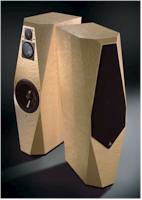 |
Frequency response (Hz) |
24 Hz - 100K Hz (+/- 1.5 dB) |
| Sensitivity (dB/1W/1m) |
87 dB (at 4 meters) |
| Impedance |
4 ohms nominal, minimum 3.6
ohms |
| Maximum power handling |
500 watts (music) |
| Recommended power |
50 - 500 watts |
| Phase correct |
No |
| Time correct |
No |
| Weight (lbs. per speaker) |
150 lbs. |
| Overall measurements (HxWxD) |
4353" x 12" x 17" |
| Recommended room size |
N/A |
| Speaker type (Traditional
cone, planer, electrostatic, horn) |
3-way conventional cone
drivers (ceramic midrange, diamond tweeter) |
| Other |
|
|
|
|
| |
| |
|
COMPANY SOUND:
These speakers have a warm,
musical midrange and a nice transparency and soundstage that
is very pleasant to the ear. The bass is somewhat compressed.
Very large amps that have a lot of bass control are required
to get the most of the lower registers, but the entire
frequency range still suffers from a slight reticence. These
speakers have a little difficulty resolving large complex
musical passages, especially at volume.
The Avalon speakers have a rich
midrange achieved with the use of a ceramic midrange (and
optionally a diamond tweeter) careful tuning of the speaker's
crossover, and the shape and construction of one of the
enclosure, with one of the most attractive enclosure finishes
in the business. The shape of the enclosure (like that of the
Marten Design speakers) helps the speakers generate an almost
360 degree soundfield (though both of which are bettered by
the MBL speakers).
Avalon was one of the first
manufacturers to build very transparent speakers at a
(somewhat) reasonable price and in a reasonable size and
weight. This interpretation is based mainly on the Avalon
Eidolon and the speaker line's overall character, especially
with respect to their microdynamic reticence and a laid back
mature, have been somewhat minimized in both the Eidolon
Diamond and, we suspect, the latest (1/2005) rev of the
Eidolon.
|
Company Sound* |
Rating 1 (poor) to
100 (fantastic) |
| Speed |
85 |
| Detail |
85 |
| Smoothness |
85 |
| Clarity |
75 |
| Agility |
80 |
| Solidity |
85 |
| Air |
85 |
| Slam |
80 |
| Naturalness |
90 |
| Transparency |
|
90 |
| Enjoyability |
95 |
|
Microdynamics |
75 |
|
Macrodynamics |
85 |
| Accuracy |
90 |
| Power |
85 |
| Drivability |
60 |
| Ergonomics |
95 |
|
Total hours spent with speakers: 14 |
Systems heard with speakers: 5 |
1425 |
|
Recommended Amplifiers:
Any large tube or relatively
high-powered solidstate amplifier. Good results have
been achieved with the large Accuphase soldistate M-8000
amp (and even the A-50V) and the large Audio Research
reference 300 and reference 600 tube amps |
|
|
| |
|
|
|
|
| |
|
|
| |
|
|
| |
|
|
| |
|
|
| |
|
|
| |
Wilson
|
X-1 Grand Slamm Series II |
$76,000.00 |
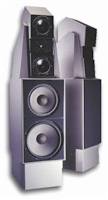 |
Frequency response (Hz) |
19.5 Hz - 22.5K Hz (-3 dB) |
| Sensitivity (dB/1W/1m) |
N/A (97 dB @ 2.83 Volts
/1 meter) |
| Impedance |
8 ohms |
| Maximum power handling |
N/A |
| Recommended power |
>20 watts |
| Phase correct |
N/A |
| Time correct |
N/A |
| Weight (lbs. per speaker) |
600 lbs. |
| Overall measurements (HxWxD) |
72" x 16.5" x 22.25" |
| Recommended room size |
|
| Speaker type (Traditional
cone, planer, electrostatic, horn) |
3-way conventional cone
drivers |
| Other |
|
|
WATT/Puppy System 7 |
$20,000.00 |
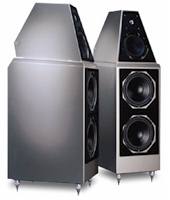 |
Frequency response (Hz) |
21 Hz - 21K Hz (+0 -3 dB) |
| Sensitivity (dB/1W/1m) |
93 dB |
| Impedance |
4 ohms nominal |
| Maximum power handling |
N/A |
| Recommended power |
>7 watts |
| Phase correct |
N/A |
| Time correct |
N/A |
| Weight (lbs. per speaker) |
170 lbs. |
| Overall measurements (HxWxD) |
40.25" x 12.25" x 18.5" |
| Recommended room size |
|
| Speaker type (Traditional
cone, planer, electrostatic, horn) |
3-way conventional cone
drivers |
| Other |
Comes apart into 2 pieces |
|
Sophia |
$12,000.00 |
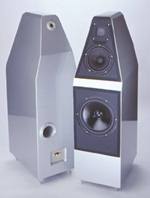 |
Frequency response (Hz) |
29 Hz - 22.5K Hz (+0 -3 dB) |
| Sensitivity (dB/1W/1m) |
N/A (89 dB @ 2.83 Volts
/1 meter) |
| Impedance |
4 ohms nominal (3 ohms
minimum) |
| Maximum power handling |
N/A |
| Recommended power |
>12 watts |
| Phase correct |
N/A |
| Time correct |
N/A |
| Weight (lbs. per speaker) |
200 lbs. |
| Overall measurements (HxWxD) |
41" x 12" x 18" |
| Recommended room size |
|
| Speaker type (Traditional
cone, planer, electrostatic, horn) |
3-way conventional cone
drivers |
| Other |
|
|
|
|
| |
| |
|
COMPANY SOUND:
The Wilson speakers specialize in
producing a somewhat forward sound with lots of midrange
detail and large scale dynamics (especially their larger
models). They are becoming more and more easy to drive over
the years, and are relatively efficient (especially their
larger models). One of the more difficult speakers with which
to optimize placement, their ability to come apart into pieces
makes them one of the easier to move speakers. Their slightly
over-emphasized midrange makes them often sound bright and
brittle, and makes their sound very sensitive to upstream
electronics. All but the largest models are lacking the
slightest bit of detail in the bass.
The Wilson speakers all use
heavily braced enclosures utilizing custom materials to reduce
harmful resonances from contaminating the speaker's sound.
They also use custom drivers in order to tailor the sound to
be exactly what Wilson wants it to be. And what they want it
to be evolves along with the industry, going from a very
forward midtrange and plentiful but un-detailed bass to a good
deal more flat frequency response in their recent models.
In this way the Wilson speakers
trail the leading edge of loudspeaker design, instead focusing
on the audiophile who has little time and incentive to do the
research to find the speaker that perfectly suits their
preferences, instead preferring to get something that is
reliable, high-quality, readily available and 'good enough'.
In this way these audiophiles may be short-changing themselves
- as not only may there be other speakers that may suit their
ear better than the Wilson, but the Wilsons, being very
sensitive to not only placement, but upstream components,
could also, in and of themselves, come a lot closer to an
audiophile's personal preferences with just a little more
attention to their system's component selection.
For example, because the Wilson
speakers now capable of generating some of the most powerful
bass of any speaker made, they are often paired with large
Krell solid-state amplifier or very large tube amp like the
VTL. But for many people this will be ultimately unsatisfying,
as most music relies on the midrange and these amps are not
known for their finesse or ability to render delicate and
intricate information in the midrange frequencies. The Wilson
to this day has a slightly emphasized midrange that is capable
of a good amount of detail - and so this deficit is even more
apparent than it may be on other speakers. The Wilson speakers
are also, traditionally, the tiniest bit on the cold side of
neutral, so a slightly musical or warm amplifier helps make
the overall presentation more natural and enjoyable.
|
Company Sound* |
Rating 1 (poor) to
100 (fantastic) |
| Speed |
95 |
| Detail |
95 |
| Smoothness |
40 |
| Clarity |
90 |
| Agility |
95 |
| Solidity |
90 |
| Air |
85 |
| Slam |
100 |
| Naturalness |
50 |
| Transparency |
|
30 |
| Enjoyability |
80 |
|
Microdynamics |
90 |
|
Macrodynamics |
100 |
| Accuracy |
90 |
| Power |
95 |
| Drivability |
90 |
| Ergonomics |
90 |
|
Total hours spent with speakers: 10 |
Systems heard with speakers: 6 |
1405 |
|
Recommended Amplifiers:
Any high-quality tube (for
example, Lamm ML1.1 or ML2 amplifiers) or relatively
sweet sounding high-quality solidstate amplifier.
|
|
|
| |
|
|
|
|
| |
|
|
| |
|
|
| |
|
|